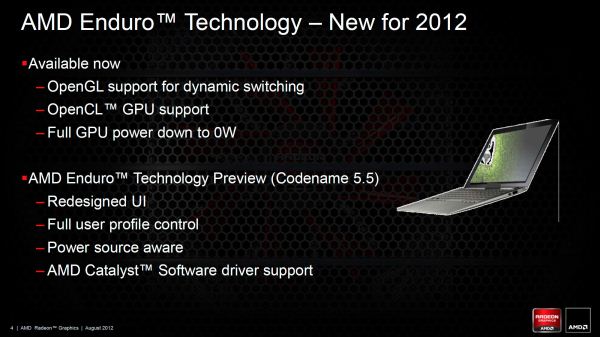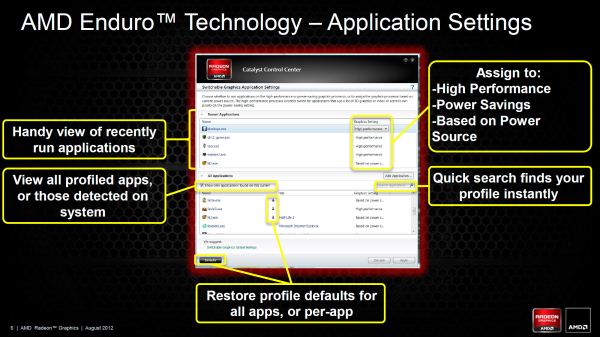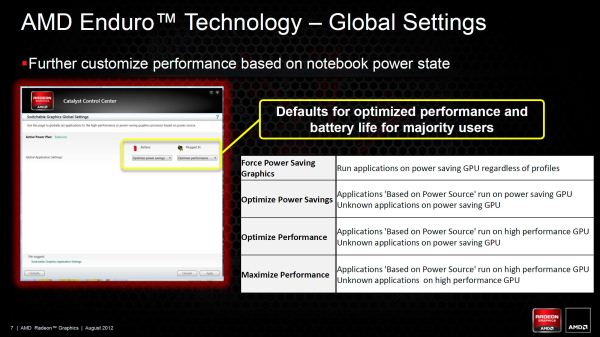AMD’s Enduro Switchable Graphics Levels Up
by Jarred Walton on September 6, 2012 3:00 AM ESTNew for Mid-2012: “Enduro 5.5” Enhancements
When AMD created the Enduro brand, they were really almost where we wanted them. They had dynamic switching with support for most of the latest games and applications, and when it worked properly it would be difficult to tell if you were using an NVIDIA or an AMD dGPU. The problem was when things didn’t work and you had to go into the drivers, and there were several problems. OpenGL support was totally out, many of the latest games were also missing default profiles (and sometimes wouldn’t let you properly specify the correct GPU), the UI was obtrusive and sometimes hard to use (particularly for power users), and the drivers were dictated by the laptop manufacturers and were usually months old at launch and never updated.
While the UI seems like a minor thing to fix—I would have thought one or two months to improve the UI would have been sufficient—at least prior to the forthcoming update it remained largely unchanged. The lack of AMD-provided driver updates was really the major issue, because everything else could potentially be fixed with new drivers and you would never know. The other areas like OpenGL/OpenCL and support for various games/applications should improve over time as well, provided you can get drivers. That brings us to the upcoming Enduro release, scheduled to come out sometime this month or next. Officially it’s still just Enduro, but to help differentiate between the previous Enduro release and the upcoming release we’ll sometimes refer to the new version as “Enduro 5.5”.
The biggest news with the latest iteration of Enduro is that AMD is planning to make universal reference drivers available for all the Enduro laptops. It’s not clear precisely what that means, but potentially any laptop with Dynamic Switchable Graphics or later (e.g. PX4.0 and later) would be supported by AMD’s “reference” drivers. That’s huge, and if AMD can deliver it will assuage most of our concerns with their hardware/software. Hopefully none of the OEMs get bent out of shape or refuse to allow support, which is a problem we've seen in the past. We should see the first public release in the next month or two, and then another release somewhere in the November/December timeframe.
Besides the availability of driver updates, the UI also receives a much needed overhaul, providing both regular and power users all the options they’re likely to need as far as control of graphics switching is concerned. Open up the switchable graphics options and the top section remains largely the same, but the bottom now allows you to see all application profiles (or just the profiles for detected applications). There’s also a quick search option that works both on executable name and application/game name (e.g. HL2.exe or Half-Life 2 will both find the profile for Half-Life 2). From either list (recently used apps up top, or all apps at the bottom), you can set the GPU profile.
Where previously there were two settings (three if you count “Not Assigned”), there are now three options. As before, “Power saving” sets an application to run on the integrated graphics while “High performance” sets an application to run on the discrete GPU. The new third option is “Based on power source”, which does precisely what you’d expect: plug the laptop in and the apps with this setting will run on the discrete GPU; switch to battery power and they’ll run on the integrated graphics. For many users, everything could default to “Based on power source” and they would be happy, but certainly there will be times where you’re running on battery power but still want to use the dGPU and the drivers give you that option. Should things get squirrelly, you can also reset applications individually or globally to their default settings. It’s worth noting that the power state aware setting is something that NVIDIA currently does not implement, requiring manual intervention if you wish to override your normal settings—though how often people are using apps that require the dGPU while on battery power is something we could debate.
Besides the individual application profiles, AMD is also adding a new area to their drivers: Switchable Graphics Global Settings. This is something you could sort of get before with some laptops, but previously it involved changing from Dynamic Switchable Graphics to manual switching (i.e. switching based on power source) and then forcing the laptop into High Performance or Power Saving mode if you wanted to be low power while plugged in or high power while unplugged. That was clunky and at least in the case of the Sony VAIO C we tested it caused flickering similar to the old switchable graphics, with the dGPU drivers getting unloaded and iGPU drivers getting loaded (or vice versa), with some work behind the scenes copying context from one GPU to the other. It worked but it wasn’t elegant; perhaps more importantly, Microsoft doesn’t want anyone doing this with Windows 8 and thus new laptops won’t be able to get a Windows 8 sticker if they use this method of switching (which basically means no new laptops will do this). To make up for the loss of this functionality (which some people still prefer), AMD has added a new global settings section.
Unlike the individual application profiles, the global settings gives you four options each for Battery and Plugged In. The top two options are similar in most cases and will generally run most applications on the iGPU, and the same goes for the bottom two modes where you’ll run most apps on the dGPU. The difference is that “Force Power Saving GPU” will run all applications (regardless of what the custom profile says) on the iGPU, essentially disabling the dGPU completely. “Optimize Power Savings” in contrast will run all unknown or “Based on power source” applications on the iGPU while respecting the application profiles where they exist. “Optimize Performance” is sort of the reverse of that, running all “Based on power source” applications on the dGPU while leaving unknown applications on the iGPU. Finally, the “Maximize Performance” option runs all unknown and “Based on power source” applications on the dGPU—but applications specifically set to use the iGPU will continue to do so.
The reason for that last discrepancy (e.g. why you can’t simply run everything on the dGPU and forget about the iGPU) is that certain tools have to run on the iGPU. Intel’s drivers are one example—loading those up on the dGPU would cause problems. Intel’s WiDi is the only other I could find on my particular Clevo notebook. We were told that some of the laptop utilities like an overlay showing percentage of brightness, volume, etc. may also need to run on the iGPU. Besides the few applications that have to run on the iGPU, any applications that are set to Power Saving will continue to use the iGPU—and this makes sense as there are a lot of applications that can be set to run on iGPU/dGPU that have no need of higher performance GPU options (several anti-virus utilities come to mind, where they're starting to create a 3D context for their UI). The net result is that other than a few specific applications where the profile will exist and be locked to the iGPU, with no option to change to dGPU, everything else that uses higher function graphics can be customized to run on a specific GPU, but if you set something to iGPU presumably you want it to always run there—otherwise you would use the “Based on power source” setting.
A full set of screenshots from all the driver screens is available in the gallery below if you’re interested.
One final topic worth discussing is Windows 8. Certainly there are owners of existing laptops with switchable graphics that are wondering if they can upgrade to Windows 8 and what will happen. We’ll have to see how this actually plays out, but it sounds like the earlier versions of PowerXpress (3.0 and earlier) will probably get support with one driver bundled with Windows 8, and that may be it—but there’s always the possibility for the laptop OEMs to release their own updates, or for AMD to roll out additional drivers for older laptops. The potential for PowerXpress 4.0 and later laptops to get regular driver updates (for Windows Vista/7/8) is there, but until we actually start seeing public driver releases AMD hasn’t fully committed to supporting all of those laptops.



















200 Comments
View All Comments
HOODY - Saturday, September 15, 2012 - link
I think this would be great for AMD, and would let users download “regular” AMD updates again as before this idiotic manufactures only OEM updates insanity. As far as I’m concerned they can even make a driver that just disables the NVIDIA chip altogether. thanks for that info,it needs to also be placed in the 7690M XT forum http://h30434.www3.hp.com/t5/Notebook-Display-and-...
HOODY - Saturday, September 15, 2012 - link
Someone mentioned to me that this was not for "powerplay switchable", shrug, All I know is the article only mentions "Switchable" nothing about powerplay, I haven't even heard or seen that term on any other forum about this switchable stuff. All it says is that the name ENDURO is now what they call Switchable.I'm also not clear just where this 7690M XT card would fall, as its just a re done 6770M, so I don't know if it would be picked up by AMD as a 7xxxx series or not either, I do know that AMD doesn't even recognize the card at all now. BTW this thing (7690M XT) is supposed to be @900MHz too, but its only showing @800MHz, so even that's misleading.
I will be upgrading my W7 home prem to W8 Pro anyway come next month, and I assume HP will have some sort of driver cobbled together by than for us OEM'ers, it will be interesting how all this shakes out with so many complaints over this switchable stuff, I wish they would just go back to true dedicated video cards and let the card makers do the drivers. I mean man, with all this technology today, one video type either ATI or NVIDIA should be able to make a single card that is able to power down automatically when it senses battery power.
JarredWalton - Tuesday, September 18, 2012 - link
PowerPlay is the technology that conserves power on the GPU when on battery power, even with the GPU still active. Basically, it lowers clocks and performance when enabled. Enduro is a separate technology to disable the dGPU completely (power it down) when it's not needed.HOODY - Tuesday, September 18, 2012 - link
OK so than just what type is on my machine? and is this new driver stuff going to be useable on my setup? Or am I still stuck with OEM crap.Radeon 7690M XT and Intel 3000, the Intel is the chip the unit switches to if on battery, the Radeon is what it uses when plugged in or switched for games. I have it set to "fixed" for now so it uses just the Radeon. But it does still ask to switch to the Intel if I unplug it the wall and go on battery.
This is a HP dv7t its still using the driver dated Nov 2011, I know about the russian site guy with the mod'ed drivers he comes up with, but they aren't exactly instalable either without having to mix and match, as one doesn't take the CCC, one doesn't take the newer Intel driver. I was hoping that this Enduro stuff was going to be the fix for people withnthis setup, to be able to again download drivers directly from AMD as they update, since waiting for these damned manufactures sucks.
2670QM
8g ram
1920x1080
W7 hp
JarredWalton - Sunday, September 30, 2012 - link
Technically, the HD 3000 (or HD 4000 on Ivy Bridge) is always enabled and running the video outputs. The 7690M only powers on when needed and it copies data over the PCIe bus into system memory or takes over some of the display ports or something funky. If you're able to configure dynamic switchable graphics, you have a PowerXpress 4.0 or later laptop and you should (eventually) get support from the Mobility Catalyst Enduro stuff.If you can only manually switch (e.g. based on power source), you're running PowerXpress 3.0 and are basically out of luck for drivers. AMD/Microsoft/Intel will probably put together one initial driver for Windows 8 to get you up and running, but I wouldn't count on anything beyond that.
Note that I am pretty sure the dv7 is a PowerXpress 4.0 laptop, so you should be okay (at some point).
TrantaLocked - Monday, October 1, 2012 - link
Jarred, I have a question that I hope AMD will feel comfortable answering if you can get in contact with them.The new-ish data transfer process (you yourself wrote about it here: http://www.anandtech.com/show/2934/nvidia-optimus-... that Nvidia used involved a hardware feature called the Optimus Copy Engine that allowed asynchronous data transferring over the PCIe bus. Before that was implemented, it was noted that as the frame rate increased in a game, the noticeable the decrease in performance became, just as it is happening NOW with AMD.
My question is simple: did AMD implement such a hardware feature, and that the feature simply needs better driver support? I trust AMD is going to fix the problem, but it seems like this issue is exactly what was happening with Nvidia...as if the hardware feature that AMD *should* have implemented isn't even being used. It troubles me that if it was implemented that AMD didn't make sure such an important feature was being driven properly.
Vozier - Sunday, September 30, 2012 - link
Here's a small post with info about the underutilization issue fix:[QUOTE=caveman-jim;8864455]Word from AMD tonight is that internal testing is going well and there is hope for a public beta driver in the next two weeks or so, maybe sooner. Sorry nothing more, that's all my connections give me.[/QUOTE]
26 SEPT.
Dido767 - Tuesday, October 23, 2012 - link
Helpppp....I can't find a way to get CS6 after effects to recognize my 7970m. I wasted hours looking for a solution but nothing!!! my dxdiag only see my onboard Intel 4000 adapter. The GPU sniffer utility that comes within the AE folder doesn't recognize the AMD as well.
Is there some workaround that I can try??
It's really frustrating because one of the reasons that I bought this laptop is for some graphic design projects and of course I want to the get most out of my card.
Anyone? plz!!
Pablito Que - Thursday, December 13, 2012 - link
I bought an AVA bare bones P150EM With the Radeon 7970m.I wondered about updating the graphics driver the moment I got it, but I called AVA Direct first because I had heard there were problems with the drivers in doing so.
This is what he told me:
"The drivers pre-installed on your computer are drivers made to interact at best performance with the intergraded graphics card on the mother board(HD graphics 4000). DO NO ATTEMPT TO DOWNLOAD AND INSTALL THE UPDATE ON AMD'S WEBSITE. THEY WILL NOT WORK PROPERLY. We try to make this clear to all who purchase the P150EM and 170, but they do not listen and think they've got it figured out. They go ahead and download the updates and the card fails! Everyone who calls us complaining about performance has tried to update the drivers when we warned them not to."
Since I have had my computer, I have had the drivers that it came with and with a 3710QM running ar 3.2 and 8 gig of RAM at 1600Mhz, I'm getting Metro 2033 at 29.9 fps with 1920x1080 and all setting maxed out minus Anti-alaising. My card has just the stock drivers and it out performs the 680M on a number of major games and was over 50% cheaper than the 680M. There's NO logical argument anyone could make for choosing the 680M over the 7970m, especially driver support issues! If the lame stock drivers already out perform Nvidia's best, then what will happen when the refined drivers are realeased? And when I say that the stock drivers out perform Nividia's, I mean in terms of frame rate from game to game- which is the ONLY thing that matters in the end.
ZippityD - Saturday, January 12, 2013 - link
Well, on my NP170EM I'm still having AMD issues with their 7970M card.I regret purchasing this card last summer. Unlike others who had problems upon updating, I began to have BSOD problems (turned out to be caused by the AMD driver) this January. The horrid trip through AMD's enduro systems has resulted in much stress and little help.
Vote with my wallet from now on, I suppose.